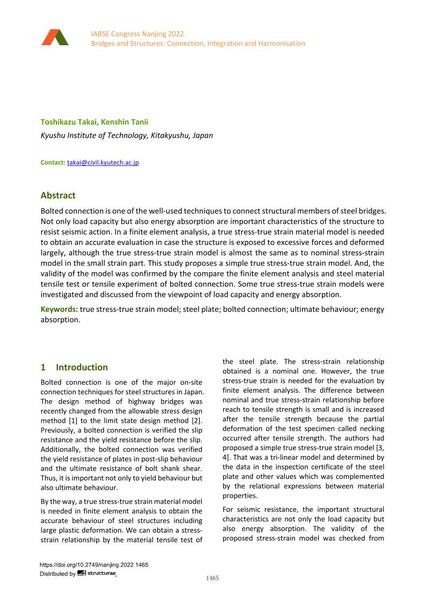Stress-strain Model Adapted to Bolted Connection in Ultimate Behaviour Considering Energy Absorption

|
|
|||||||||||
Bibliographic Details
| Author(s): |
Toshikazu Takai
(Kyushu Institute of Technology, Kitakyushu, Japan)
Kenshin Tanii (Kyushu Institute of Technology, Kitakyushu, Japan) |
||||
|---|---|---|---|---|---|
| Medium: | conference paper | ||||
| Language(s): | English | ||||
| Conference: | IABSE Congress: Bridges and Structures: Connection, Integration and Harmonisation, Nanjing, People's Republic of China, 21-23 September 2022 | ||||
| Published in: | IABSE Congress Nanjing 2022 | ||||
|
|||||
| Page(s): | 1465-1472 | ||||
| Total no. of pages: | 8 | ||||
| DOI: | 10.2749/nanjing.2022.1465 | ||||
| Abstract: |
Bolted connection is one of the well-used techniques to connect structural members of steel bridges. Not only load capacity but also energy absorption are important characteristics of the structure to resist seismic action. In a finite element analysis, a true stress-true strain material model is needed to obtain an accurate evaluation in case the structure is exposed to excessive forces and deformed largely, although the true stress-true strain model is almost the same as to nominal stress-strain model in the small strain part. This study proposes a simple true stress-true strain model. And, the validity of the model was confirmed by the compare the finite element analysis and steel material tensile test or tensile experiment of bolted connection. Some true stress-true strain models were investigated and discussed from the viewpoint of load capacity and energy absorption. |
||||
| Keywords: |
energy absorption bolted connection Steel Plate ultimate behaviour true stress-true strain model
|
||||
| Copyright: | © 2022 International Association for Bridge and Structural Engineering (IABSE) | ||||
| License: | This creative work is copyrighted material and may not be used without explicit approval by the author and/or copyright owner. |
||||
